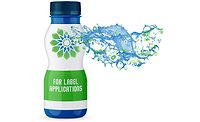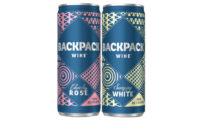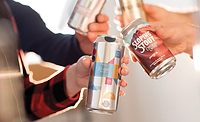Premium beverages, sustainability drive labeling material trends
Matte finishes and new textures dominate labeling material trends


CP Flexible Packaging’s C-FiT no-heat shrink look is an alternative to low- to medium-shrink applications, according to Jim Mallon. It offers reduced energy for application because it has no heat tunnel, a reduced carbon footprint and is designed for PET bottle recycling. (Image courtesy of CP Flexible Packaging)

Printpack’s James Taylor cites the Gatorade G-Series redesign noting the more stout, hour-glass shaped PET bottle as well as the full-body, high-shrink label that offers a billboard with clear windows, graphics and color schemes. He says that same concept is benefiting nutrition, natural teas and juices. (Image courtesy of PepsiCo)

Fort Dearborn’s Gwen Chapdelaine says the company offers a variety of paper and film substrates as well as design and finishing effects. This example shows the company’s shrink sleeve with metallic ink and a matte finish. (Image courtesy of Fort Dearborn Co.)




Beverage marketers know that packaging plays an important role in sales. Just as important as the bottle or can that a beverage is packaged in, is how that package is labeled. Without it, consumers couldn’t tell which brand is which.
According to experts, labeling materials have been innovating to accommodate new consumer demands. “Consumers have become increasingly savvy, with a growing appreciation of — and demand for — packaging aesthetics,” says Laura Clark, global marketing director of beverages for Avery Dennision Label and Packaging Materials, Gendale, Calif. “Product shelf appeal is a must-have, and [consumer packaged goods] (CPG) companies worldwide are finding shelf power equates to brand power.
“The need to succeed at shelf is encouraging packaging designers to innovate materials,” she continues. “And many are combining technological innovations with interactivity to attract consumer attention.”
She notes that consumers today are looking for an experience from labels. Thermochromatic inks, electroluminescent labels, special coatings, changing packaging colors, screen printing, uniquely shaped bottles and matte finishes all contribute to creating a packaging experience for the consumer, she says.
High standards
One of the strongest trends driving innovation and change in labeling material choices is consumer demand for premium beverages. These products tend to be more aesthetically appealing, which experts say can be a driving factor in purchases. “The drive toward premium beverages has corresponded to use of more premium labeling materials such as films and specialty papers,” says Gwen Chapdelaine, marketing director for Fort Dearborn Co., Elk Grove, Ill.
Clark says that the push of premiumization opens doors for new sensory aesthetics to labels. “With the drive toward premiumization, brands are using touch and feel to engage consumers, including stamping and embossing,” she says. “Pressure-sensitive labels enable greater flexibility in design and label shape.”
According to Clark, Avery Dennison offers its Prime Film Portfolio featuring ClearCut, a label and adhesive technology, for premium pilsners. The company also offers the S7400 and S7000 adhesives, she says.
Don Earl, president of Overnight Labels Inc., Deer Park, N.Y., notes. “Premium brands always raise the packaging bar,” he says. Additionally, experts agree that as a result, matte-style labels have been one of the largest trends within the past year, due to the push of premium products.
According to Louis Iovoli, vice president of strategic partnerships at Hammer Packaging Corp., Rochester, N.Y., this might be because premium products tend to have more flexibility with costs and have the opportunity to select materials that better reflect the brand, such as metallized or clear film, among others.
According to James Taylor, business development manager at Printpack US, Atlanta, these aesthetic features allow premium beverages to differentiate themselves from all the other beverage options on the shelf. “Premium brands and new product introductions are differentiating themselves through contoured and embossed bottles,” he explains. “The goal is to move as far away from a partial and loosely wrapped straight-wall bottle that is now commoditized. When combined with functional labeling, a new bottle is a powerful image and experience.
“Take for example, the recent Gatorade G-Series bottle redesign. A more stout and hour-glass shaped PET bottle was designed to fit better in the athlete’s hands and convey strength,” Taylor continues. “A full-body, high-shrink label offers and exceptional billboard including clear windows, graphics and color schemes, which express the high performance brand identity of the product. The same concept is benefiting nutrition, natural teas and juices.”
However, according to Taylor, even premium product labeling differs by category. “As technologies in bottling label materials emerge, we expect to see a trend to differentiate premium and new entries in water through bottle shapes and features that will employ enhanced labeling options,” Taylor explains. “We expect specialty juices, teas, nutritional supplements and sports drinks to continue to align unique bottle shapes and styles with full-body shrink labels that complement a premium design.”
Sticking to sustainability
Every part of the packaging process has felt the pressure of sustainability and “going green.” However, suppliers say that labeling materials have easily adapted to accommodate this growing concern. “Sustainability is becoming more of a concern when looking for new or alternative labeling designs,” affirms Jim Mallon, director of sales and marketing at CP Flexible Packaging, York, Pa.
He adds that the company’s new C-FiT no-heat shrink look is an alternative to low- to medium-shrink applications. It offers reduced energy for application, because it has no heat tunnel, a reduced carbon footprint and is designed for PET bottle recycling.
Fort Dearborn’s Chapdelaine explains that the industry has been able to overcome sustainability challenges. “Sustainability trends have translated into thinner materials (downgauging) as bottles have been lightweighted and developments in materials support recycling efforts,” she says.
“[Sustainability’s] meant a move to thinner overall constructions to reduce material, and a thinner film and liner that’s purpose-built for the recycling process,” Avery Dennison’s Clark adds. “Avery Dennison has met challenges such as using less adhesive coat weight while enhancing performance and wet-out through offering such as ClearCut adhesives. In addition these adhesives result in less scrap by limiting ooze.
“On the paper side, we have addressed being more sustainable by offering an extensive portfolio of price-neutral FSC(R)-certified facestocks,” she continues. “A subset of the portfolio is featured in our wine and spirits materials collection.”
Overnight Label’s Earl adds that more beverage-makers are inquiring about sustainable/recyclable options like polyethylene terephthalate glycol-modified (PETG) and polylactic acid (PLA).
However, according to Hammer Packaging’s Iovoli, beverage-makers also have been requesting other sustainable and recyclable labeling options. “Customers have made requests for everything from post-consumer papers, floatable shrink-sleeve materials, lighter weights and energy-curable ink and coating systems to be more environmentally friendly,” Iovoli says. He says that Hammer Packaging offers Electron Beam inks and coatings that are environmentally friendly and offer an opportunity for a label to pop.
Additionally, suppliers note that labels also have had to conform to certain recycling requirements. “At the urging of the recycling industry, film and label manufacturers have successfully developed alternatives to traditional materials that were contaminates in the bottle recycling process to those that are compatible,” Printpack’s Taylor explains. “Additionally, new applicator technologies — when paired with recent shrink film materials — can be efficiently applied using no glues or solvents and, in some cases, with minimal investments on existing assets.”
Avery Dennison’s Clark adds: “From a sustainability standpoint, filmic labels have a thinner overall construction. Brands must be aware of the recycling process available in their target markets.”
Choosing your label
When choosing a label, experts note that there are many aspects to consider, and beverage-makers always are looking for a new edge when it comes to their labels on the ever-competitive store shelves. “The store shelf is a very competitive environment,” Hammer Packaging’s Iovoli says. “Our customers are always asking for methods and techniques to be distinctive. We see a growing trend in the use of digital printing combined with conventional production to make packaging more interactive and relevant to consumers.”
Printpack’s Taylor adds several factors that can affect labeling material choices. “The container size, shape and desired functionality that align with the growing variety of brand and categories are broadening the array of product solutions,” he explains. “Additionally, applicator and filling systems employed by manufacturers and co-packers affect material choice. These include PETG and polyolefin for contoured containers, BOPP for non-shrink applications, [polyvinyl chloride] (PVC) for tamper bands and layer materials for high-speed welded application.”
Fort Dearborn’s Chapdelaine adds that brand owners are at no loss for aspects to consider when designing a beverages label. “Aside from the different materials, inks, coatings and finishing options, there are other ways to make labels more impactful including digital (personalization, variable imaging), fluorescent, foil, glow-in-the-dark, holographic, matte, metallic, pearlescent, scented, soft touch, tactile, thermochromatic.”
With all of these options, it might seem overwhelming choosing what is right for a brand. However, experts say that there are several resources to help. “It’s important to consult directly with a converter with demonstrated success and experience with a broad base of materials to ensure the most effective and efficient performance,” Printpack’s Taylor says. “Don’t limit yourself by working with a single film type or applicator method – work with a preferred converter that has access to many solutions to ensure your success.”
He says that to be more impactful on the shelf, beverage-makers should begin with a unique container and then utilize the space it offers with vibrant, full-color graphics. “Integrate the label design with the primary container product and the container through windows and clear space,” he suggests.
Taylor notes that Printpack works with film substrates only such as glue-applied wrap-around, TD shrink sleeves and MD roll-applied high-shrink. “Printpack uses a variety of functional film materials that meet the prescribed needs of our customer applications,” he says. “They include PETG, OPS, polyolefin, multilayer blends, OPP and PVC.”
Additionally, Overnight Label’s Earl suggests that a beverage-maker finds a designer that understands both the printing process and how to get the most out of the available coatings and substrates. “A designer that understands substrates and coatings can make a design pop,” he says.
However, Earl says that when choosing a material, the most important factor to consider is the labeling ability of the co-packer. “Bottle shape and the budget for the project also are important things to consider,” he adds.
Avery Dennison’s Clark explains that when choosing which materials to use, a beverage-maker should be driven by a combination of design, bottle size, shape and color, and which printing effects will be used. “Papers offer a wider variety of textures and colors, which are great for design and shelf appeal,” she says. “Film is more durable to scuff and ice bucket challenges and is durable for a ‘no-label’ design. Overall, brand owners should consider their total applied cost, which includes scrap from line breaks and mislabeled bottles, application equipment and speeds, and the minimum order quantity for their SKUs.”
Chapdelaine stresses that the brand’s objectives should be at the heart of the decisions as well. “Beverage-makers should consider the brand objectives, container type and shape, product environment and usage conditions — moisture resistance, etc. — and application equipment type when choosing the most effective labeling material,” she suggests.
Chapdelaine adds that Fort Dearborn offers a variety of paper and film substrates as well as design and finishing effects including cut and stack in several varieties, shrinkable film, pressure sensitive, roll-fed and shrink sleeves.
Labeling the future
Just as the beverage industry itself will continue to evolve as it innovates, experts anticipate the same from beverage labeling materials.
Avery Dennison’s Clark notes that labels have benefited from improvements in tracking technology. “RFID and our DirectLink technology could play a part in changing the role of labels in this space. It’s really an issue of price,” she says. “Smart technology is much more point-of-sale driven, or perhaps by the case. We see it more for spirits than beer at this point, or for higher volume consumer goods. Applying smart technology would perhaps double the cost per label on premium pilsner at high volume. That said, RFID can play a role at case pack or pallet levels for tracking, and indicating time and temperature to ensure that the beverage doesn’t experience negative environmental conditions.”
On the other hand, Fort Dearborn’s Chapdelaine notes four areas that will continue innovating in the future. “Sustainability: continue trends toward downgauging labels and a growing interest in eco-friendly labeling materials; shelf impact: developments in inks, coatings and substrates; functionality: developments that allow for shelf-life extension lightweighting of containers; [and] digital printing: more interest in digital printing for mass customization and limited editions,” she says.
Hammer Packaging’s Iovoli agrees that shelf-impact has, literally, a bright future ahead of it. “I think technology is getting closer for lighted material to be included on a label,” Iovoli says. “Ultimately, this could lead to video. Labeling will be more interactive. The days of the static design will be something we talk about to grandchildren in the future.”
Printpack’s Taylor’s outlook to the future is all about sustainability. “Look for higher shrink percentages with lower gauge and force, more sustainable options, both from a pure material composition and compatibility with recycling, and a low-no VOC method for streaming,” he says.
Looking for a reprint of this article?
From high-res PDFs to custom plaques, order your copy today!











